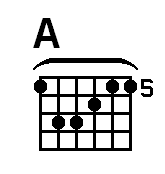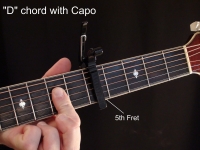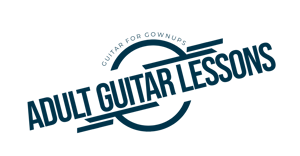 A capo is a device that is used on the guitar to allow the guitarist to play open chord formations in positions higher up the neck without having to play barre chords.
A capo is a device that is used on the guitar to allow the guitarist to play open chord formations in positions higher up the neck without having to play barre chords.
It is designed to “clamp” down on the neck and barre all the strings across a fret, thereby becoming the “nut” for that position. (see “Parts of the Guitar”)

A capo is often used by singer/songwriters to play a song in a different key, but still be able to play the song using “open” chord formations that would normally only be possible lower on the neck.
Capos are also used occasionally by lead guitarists that want to play open position scales and licks in a higher position on the neck.
To illustrate, look at the first diagram. This is an “A” chord that is “barred” at the 5th fret. The first finger acts as the barre and the “A” chord is then formed using the three remaining fingers.

If you wanted to play this chord without having to barre it, you could use a capo. The capo would be “clamped” across the 5th fret in place of using the 1st finger. Then the “A” chord could be formed using the same fingering as you would an “E” chord in the open position.
The next diagram illustrates a “D” chord also played by barring the  5th fret. If, as in the previous example, you clamped a capo on the 5th fret in place of using the 1st finger as a barre, you could then play the “D” chord using the same fingering as you would an “A” chord in the open position.
5th fret. If, as in the previous example, you clamped a capo on the 5th fret in place of using the 1st finger as a barre, you could then play the “D” chord using the same fingering as you would an “A” chord in the open position.
Just like barre chords, a capo  will allow you to change the “voicing” of a chord. An “E” chord played by barring the 7th fret will have a different sound than an “E” chord played in the open position, even though they are the same chord.
will allow you to change the “voicing” of a chord. An “E” chord played by barring the 7th fret will have a different sound than an “E” chord played in the open position, even though they are the same chord.
When first applying a capo to the guitar it can sometimes take a little tweaking to find the “sweet spot” of the fret where the capo is most effective. A little too low or too high on the fret and the guitar can lose intonation and sound out of tune. In some cases you will actually need to re-tune a bit once the capo is in place.
 Capos come in all shapes and sizes and finding the one that works best for you may simply be a matter of trial and error. There are capos made specifically for the acoustic guitar, electric guitar, classical guitar, mandolin, banjo and more.
Capos come in all shapes and sizes and finding the one that works best for you may simply be a matter of trial and error. There are capos made specifically for the acoustic guitar, electric guitar, classical guitar, mandolin, banjo and more.
Some capos have a “cut out” at one or more of the string positions to allow open strings to ring out while the capo is in place higher on the neck. There are capos that cover only three or four strings and every combination imaginable.
The easiest way to get started is to get a standard capo for your particular guitar, clamp it on a fret, and play around with playing your open chord formations. It will open up a world of possibilities with your playing and songwriting.
Please do not hesitate to contact us with any questions!



